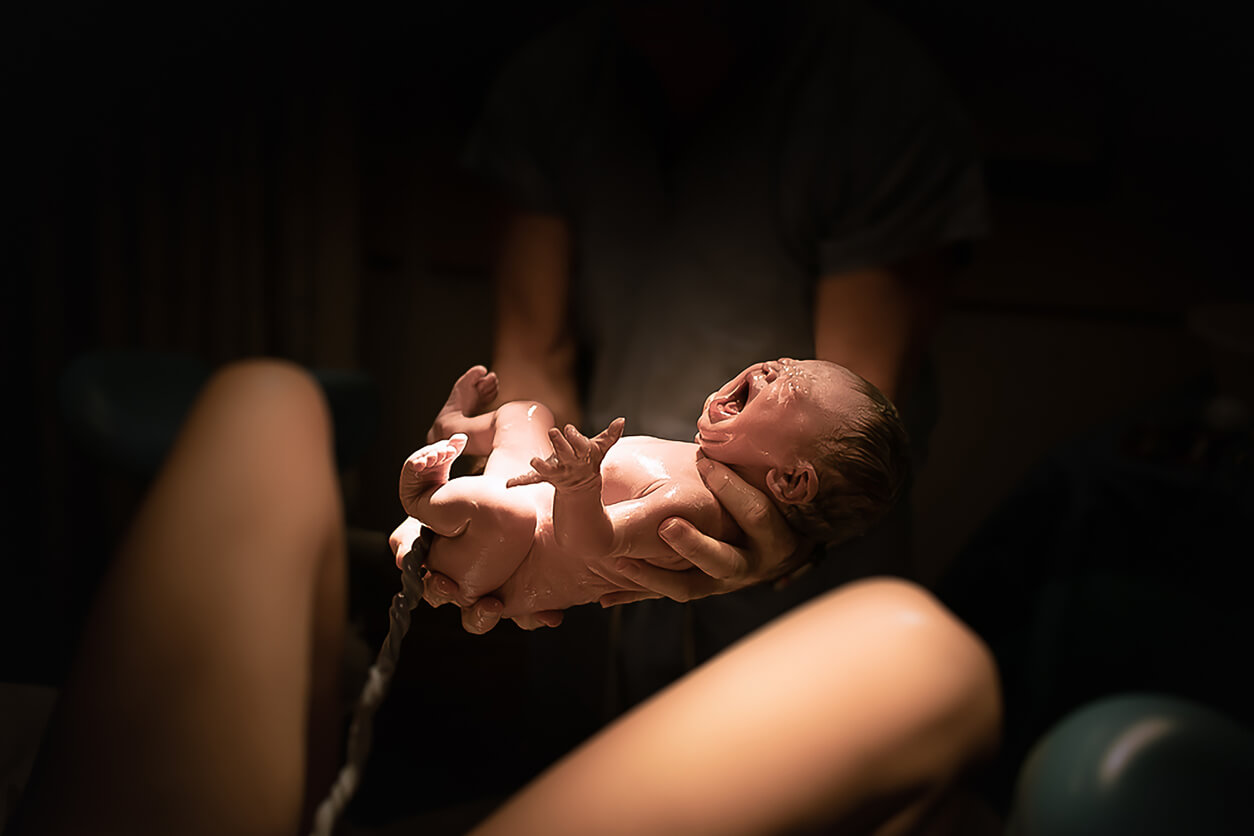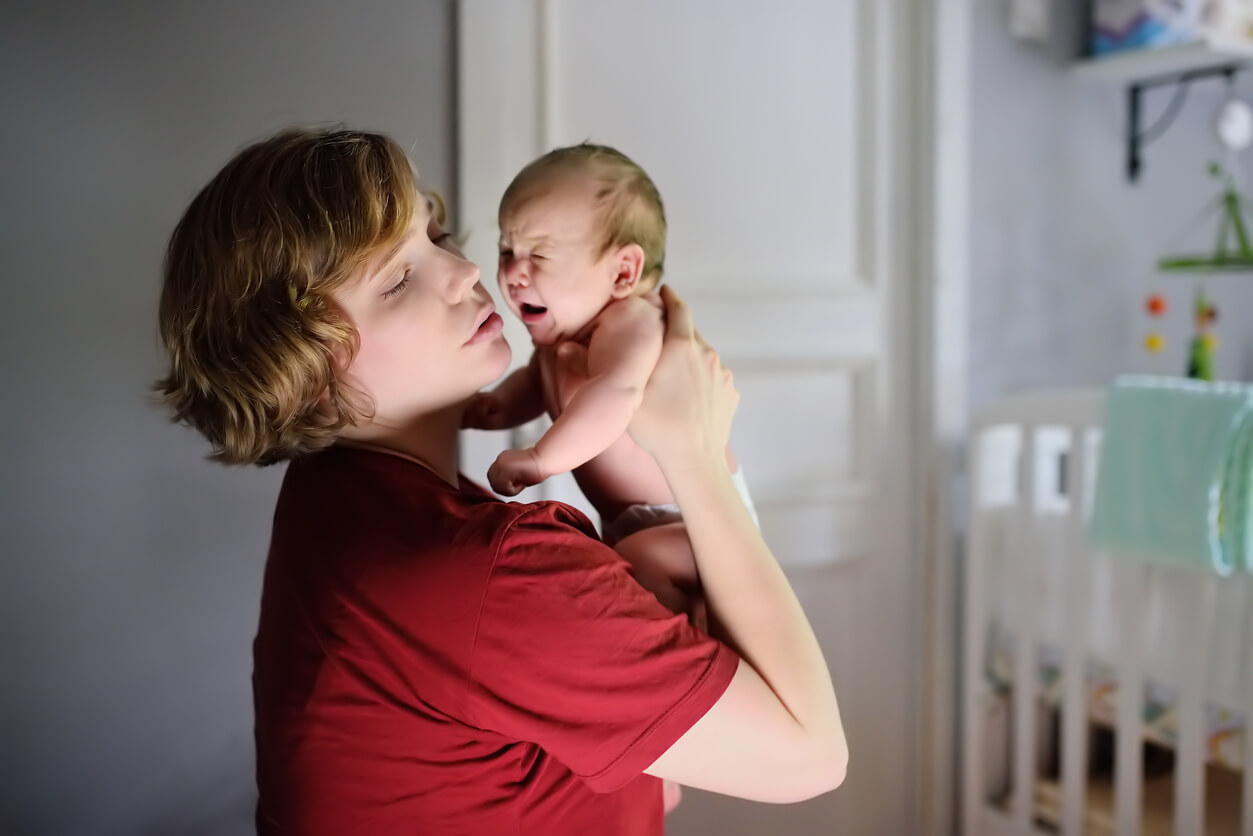A Baby's First Cry: What You Need to Know

After 9 months of carrying your baby in your womb, it’s time to finally meet your little one, to touch your baby, and to start a new life with it. Your baby’s first cry indicates that everything went well during labor and that your child is able to breathe on their own.
In addition to giving you relief, this first cry contributes to the well-being of both of you. That’s why we want to tell you all about its implications and what to expect from this unforgettable moment. Don’t miss it!
Why does a baby’s first cry occur?
At birth, most babies respond with a shrill cry, which happens for several reasons.
First of all, the cry is a reflection of the vibrations of the vocal cords during the first expulsion of air from the lungs (exhalation). Often a loud cry isn’t heard, but rather a slight gasp. The important thing is that it fulfills its fundamental purpose: To free the airways of amniotic fluid to allow air from the environment to enter.
At the same time, the baby’s first cry represents the response to the enormous change in the environment that they’re experiencing. We mustn’t forget that just a few minutes before, the little one was warm and comfortable inside its mother’s body and now it has to learn to fend for itself. Although it continues to depend on its caregivers in many aspects, it must breathe on its own, look for food, and adapt its body to a totally different climate.
In short, being born is a very stressful time for babies and it’s therefore essential to ensure skin-to-skin contact as soon as possible. Feeling the smell, voice, and warmth of its mother will help it calm its anxiety and feel protected.

Characteristics of the first cry
The baby’s first cry has some characteristics that don’t make it more or less normal, nor better or worse than any other. Each baby has a different way of doing it and we’re going to tell you what it means:
- The baby’s cry is loud and strident. In general, healthy babies cry loudly at birth, as part of the adaptive mechanism mentioned above. It doesn’t necessarily imply pain or discomfort, but simply the stress of an abrupt change of environment.
- When the cry is passive but effective, it may mean that the baby was asleep and relaxed before leaving the womb. This is often the case with planned cesarean sections, as virtually no cooperation is required on their part in the birthing process. What will make the difference with the next type is the normality of the rest of the parameters of the Apgar scale.
- The baby doesn’t cry or cries very weakly. This may indicate an inadequate adaptation to the extrauterine environment, either because of a lack of pulmonary maturity or because of some gestational or delivery complication. In this case, the child should be evaluated as soon as possible and assisted if necessary.
You may be interested in: Respiratory Distress Syndrome in Newborns
The benefits of the first cry for mother and baby
In the previous sections, we focused on the advantages of the first cry on the baby’s physical health, but they’re not limited to that. In fact, it also offers benefits to the mother. Here are its main virtues:
- It helps to free the airways from the amniotic fluid present in them.
- It stimulates the onset of the newborn’s respiratory work.
- It contributes to circulatory changes in the baby’s body (transition from fetal to neonatal circulation).
- It offers numerous psychological benefits for the mother: It brings calmness and relief after childbirth and favors the release of substances essential for the establishment of attachment.
- It triggers the production of oxytocin, which is a key hormone for the retraction of the uterus and for the initiation of lactation.
Crying is also a way to communicate
In addition to physiological reasons, crying occurs as a form of communication between the baby and the surrounding environment. It’s the baby’s only way to express if it’s afraid, nervous, in pain, hungry, or in need of affection.
When the baby cries, it triggers multiple reactions in its mother’s brain in an instinctive way. Several studies have been carried out on baby crying from which some interesting conclusions have been drawn:
-
Although people watching a baby cry may not recognize the cause of the crying, their brain reacts more when they perceive it to be a manifestation of pain than when it is the product of fear or anger.
-
When babies cry out of fear or anger, their eyes remain open. But when the cause is pain, they keep them practically closed.
- Gradually increasing infant crying usually occurs because of anger or dissatisfaction. On the contrary, crying due to pain or fear starts with great intensity and stays this way.

About the baby’s first cry we can say
You’ve already seen that knowing why a baby cries is very relevant, both in the first moment and afterward. We mustn’t forget that this is their only way of communicating, both to ask for and to externalize their emotions. In particular, the first cry offers multiple benefits for the health of the mother and the baby and is a fundamental act for the adaptation to the extrauterine environment.
In short, the body is very wise and everything that happens naturally has a purpose. In this case, nature ensures that all our attention is directed towards this little one who has just arrived in our lives to change them completely.
After 9 months of carrying your baby in your womb, it’s time to finally meet your little one, to touch your baby, and to start a new life with it. Your baby’s first cry indicates that everything went well during labor and that your child is able to breathe on their own.
In addition to giving you relief, this first cry contributes to the well-being of both of you. That’s why we want to tell you all about its implications and what to expect from this unforgettable moment. Don’t miss it!
Why does a baby’s first cry occur?
At birth, most babies respond with a shrill cry, which happens for several reasons.
First of all, the cry is a reflection of the vibrations of the vocal cords during the first expulsion of air from the lungs (exhalation). Often a loud cry isn’t heard, but rather a slight gasp. The important thing is that it fulfills its fundamental purpose: To free the airways of amniotic fluid to allow air from the environment to enter.
At the same time, the baby’s first cry represents the response to the enormous change in the environment that they’re experiencing. We mustn’t forget that just a few minutes before, the little one was warm and comfortable inside its mother’s body and now it has to learn to fend for itself. Although it continues to depend on its caregivers in many aspects, it must breathe on its own, look for food, and adapt its body to a totally different climate.
In short, being born is a very stressful time for babies and it’s therefore essential to ensure skin-to-skin contact as soon as possible. Feeling the smell, voice, and warmth of its mother will help it calm its anxiety and feel protected.

Characteristics of the first cry
The baby’s first cry has some characteristics that don’t make it more or less normal, nor better or worse than any other. Each baby has a different way of doing it and we’re going to tell you what it means:
- The baby’s cry is loud and strident. In general, healthy babies cry loudly at birth, as part of the adaptive mechanism mentioned above. It doesn’t necessarily imply pain or discomfort, but simply the stress of an abrupt change of environment.
- When the cry is passive but effective, it may mean that the baby was asleep and relaxed before leaving the womb. This is often the case with planned cesarean sections, as virtually no cooperation is required on their part in the birthing process. What will make the difference with the next type is the normality of the rest of the parameters of the Apgar scale.
- The baby doesn’t cry or cries very weakly. This may indicate an inadequate adaptation to the extrauterine environment, either because of a lack of pulmonary maturity or because of some gestational or delivery complication. In this case, the child should be evaluated as soon as possible and assisted if necessary.
You may be interested in: Respiratory Distress Syndrome in Newborns
The benefits of the first cry for mother and baby
In the previous sections, we focused on the advantages of the first cry on the baby’s physical health, but they’re not limited to that. In fact, it also offers benefits to the mother. Here are its main virtues:
- It helps to free the airways from the amniotic fluid present in them.
- It stimulates the onset of the newborn’s respiratory work.
- It contributes to circulatory changes in the baby’s body (transition from fetal to neonatal circulation).
- It offers numerous psychological benefits for the mother: It brings calmness and relief after childbirth and favors the release of substances essential for the establishment of attachment.
- It triggers the production of oxytocin, which is a key hormone for the retraction of the uterus and for the initiation of lactation.
Crying is also a way to communicate
In addition to physiological reasons, crying occurs as a form of communication between the baby and the surrounding environment. It’s the baby’s only way to express if it’s afraid, nervous, in pain, hungry, or in need of affection.
When the baby cries, it triggers multiple reactions in its mother’s brain in an instinctive way. Several studies have been carried out on baby crying from which some interesting conclusions have been drawn:
-
Although people watching a baby cry may not recognize the cause of the crying, their brain reacts more when they perceive it to be a manifestation of pain than when it is the product of fear or anger.
-
When babies cry out of fear or anger, their eyes remain open. But when the cause is pain, they keep them practically closed.
- Gradually increasing infant crying usually occurs because of anger or dissatisfaction. On the contrary, crying due to pain or fear starts with great intensity and stays this way.

About the baby’s first cry we can say
You’ve already seen that knowing why a baby cries is very relevant, both in the first moment and afterward. We mustn’t forget that this is their only way of communicating, both to ask for and to externalize their emotions. In particular, the first cry offers multiple benefits for the health of the mother and the baby and is a fundamental act for the adaptation to the extrauterine environment.
In short, the body is very wise and everything that happens naturally has a purpose. In this case, nature ensures that all our attention is directed towards this little one who has just arrived in our lives to change them completely.
All cited sources were thoroughly reviewed by our team to ensure their quality, reliability, currency, and validity. The bibliography of this article was considered reliable and of academic or scientific accuracy.
- Chóliz M, Fernández-Abascal EG, Martínez-Sánchez F. Infant crying: pattern of weeping, recognition of emotion and affective reactions in observers. Span J Psychol. 2012 Nov;15(3):978-88. doi: 10.5209/rev_sjop.2012.v15.n3.39389. PMID: 23156907. Disponible en: https://pubmed.ncbi.nlm.nih.gov/23156907/
- Repetti, C. (Ed.). (2007). El libro del bebé. Editorial Albatros.
- Eisenberg, A., Murkoff, H. E., & Hathaway, S. E. (1995). El primer año del bebé. Editorial Norma.
- Perez Velez, M. A. (2012). Como entender a tu bebé: primer año de vida.
This text is provided for informational purposes only and does not replace consultation with a professional. If in doubt, consult your specialist.








